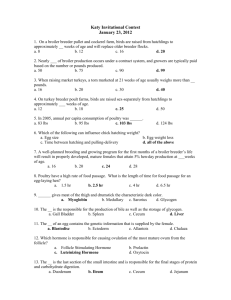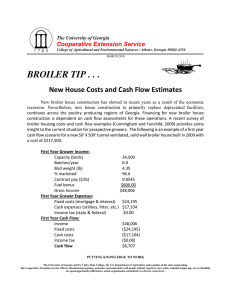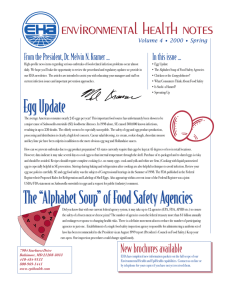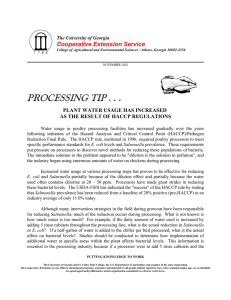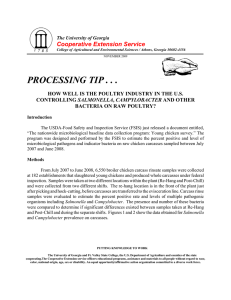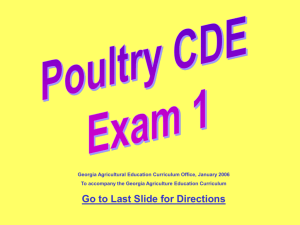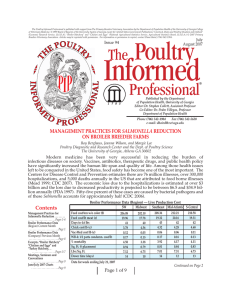Document 13161495
advertisement
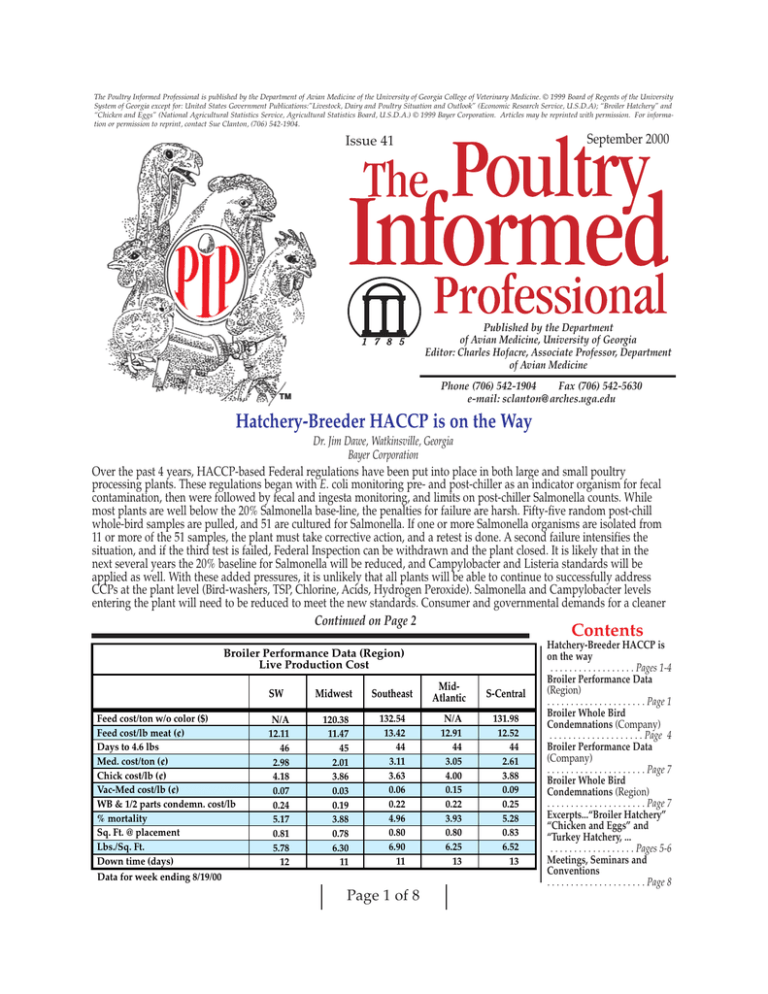
The Poultry Informed Professional is published by the Department of Avian Medicine of the University of Georgia College of Veterinary Medicine. © 1999 Board of Regents of the University System of Georgia except for: United States Government Publications:”Livestock, Dairy and Poultry Situation and Outlook” (Economic Research Service, U.S.D.A); “Broiler Hatchery” and “Chicken and Eggs” (National Agricultural Statistics Service, Agricultural Statistics Board, U.S.D.A.) © 1999 Bayer Corporation. Articles may be reprinted with permission. For information or permission to reprint, contact Sue Clanton, (706) 542-1904. September 2000 Issue 41 Published by the Department of Avian Medicine, University of Georgia Editor: Charles Hofacre, Associate Professor, Department of Avian Medicine Phone (706) 542-1904 Fax (706) 542-5630 e-mail: sclanton@arches.uga.edu Hatchery-Breeder HACCP is on the Way Dr. Jim Dawe, Watkinsville, Georgia Bayer Corporation Over the past 4 years, HACCP-based Federal regulations have been put into place in both large and small poultry processing plants. These regulations began with E. coli monitoring pre- and post-chiller as an indicator organism for fecal contamination, then were followed by fecal and ingesta monitoring, and limits on post-chiller Salmonella counts. While most plants are well below the 20% Salmonella base-line, the penalties for failure are harsh. Fifty-five random post-chill whole-bird samples are pulled, and 51 are cultured for Salmonella. If one or more Salmonella organisms are isolated from 11 or more of the 51 samples, the plant must take corrective action, and a retest is done. A second failure intensifies the situation, and if the third test is failed, Federal Inspection can be withdrawn and the plant closed. It is likely that in the next several years the 20% baseline for Salmonella will be reduced, and Campylobacter and Listeria standards will be applied as well. With these added pressures, it is unlikely that all plants will be able to continue to successfully address CCPs at the plant level (Bird-washers, TSP, Chlorine, Acids, Hydrogen Peroxide). Salmonella and Campylobacter levels entering the plant will need to be reduced to meet the new standards. Consumer and governmental demands for a cleaner Continued on Page 2 Contents Broiler Performance Data (Region) Live Production Cost Feed cost/ton w/o color ($) Feed cost/lb meat (¢) Days to 4.6 lbs Med. cost/ton (¢) Chick cost/lb (¢) Vac-Med cost/lb (¢) WB & 1/2 parts condemn. cost/lb % mortality Sq. Ft. @ placement Lbs./Sq. Ft. Down time (days) SW Midwest Southeast MidAtlantic S-Central N/A 12.11 46 2.98 4.18 0.07 0.24 5.17 0.81 5.78 12 120.38 11.47 45 2.01 3.86 0.03 0.19 3.88 0.78 6.30 11 132.54 13.42 44 3.11 3.63 0.06 0.22 4.96 0.80 6.90 11 N/A 12.91 44 3.05 4.00 0.15 0.22 3.93 0.80 6.25 13 131.98 12.52 44 2.61 3.88 0.09 0.25 5.28 0.83 6.52 13 Data for week ending 8/19/00 Page 1 of 8 Hatchery-Breeder HACCP is on the way . . . . . . . . . . . . . . . . . . Pages 1-4 Broiler Performance Data (Region) . . . . . . . . . . . . . . . . . . . . . Page 1 Broiler Whole Bird Condemnations (Company) . . . . . . . . . . . . . . . . . . . . Page 4 Broiler Performance Data (Company) . . . . . . . . . . . . . . . . . . . . . Page 7 Broiler Whole Bird Condemnations (Region) . . . . . . . . . . . . . . . . . . . . . Page 7 Excerpts...“Broiler Hatchery” “Chicken and Eggs” and “Turkey Hatchery, ... . . . . . . . . . . . . . . . . . . Pages 5-6 Meetings, Seminars and Conventions . . . . . . . . . . . . . . . . . . . . . Page 8 Hatchery-Breeder HACCP is on the Way Continued from Page 1 finished product will impact sales and marketing of broilers - those companies that meet the standards will be rewarded with the premium markets, both domestic and export. Just as the consumer, the plant and corporate leaders have shifted breeder decisions based on cost, yield and markets, so will they move HACCP further up-stream through broiler, breeder and Primary Breeder live production. Where Are We Now On HACCP? (July, 2000) Survey of 3 Largest Domestic Primary Breeders 1. QUESTION: What % of your customers are requesting Salmonella negative breeder chicks? ANSWER: U.S. Producers - 1% / 25% / 0% Foreign Producers - 50% / 100% / 50% 2. QUESTION: Primary breeders currently guarantee S.E. and S.T. negative stock. When will you be able to ship 100% Salmonella negative chicks? ANSWER: Primary #1 - 2-3 years minimum Primary #2 - 1 year Primary #3 - 5 years 3. QUESTION: Are Best Management Practices (BMPs) written and operating in your company, including Salmonella monitoring and reduction efforts, and vector control through Integrated Pest Management (IPM) including written records, from Pedigrees to Hatchery? ANSWER: Primary #1 - yes Primary #2 - yes Primary #3 - yes 4. QUESTION: What Salmonella reduction methods are used in your current programs? ANSWER: (combined) - Salmonella vaccines - Strategic use of Competitive Exclusion (C.E.) products following antibiotics - Integrated Pest Management (IPM) - Rodents, flies, beetles, wild birds - Routine Salmonella culturing - Drag swabs, Hatchery fluff, chick paper, hatchery residue, yolk-sac culture, finished feed and ingredients - Pelleting or conditioning all feeds, acid/formaldehyde treatment of feeds/floors - Biosecurity 5. QUESTION: Primary Breeders must use long-range planning regarding market shifts since it takes about 5 years for a genetic change to “travel” the generations between Pedigree and Broiler. Regarding HACCP, Food Safety and BreederHatcheries at the Integrator level, where do you think they will be in 5 - 7 years? ANSWER: All upper managers and health specialists interviewed felt that the pressures to reduce Salmonella and Campylobacter loads going into the plant will increase dramatically as the tolerance limits are lowered, and that more companies will begin to institute HACCP principles on the live production side, including broiler, breeder and hatchery components. As more plant failures occur and foreign markets demand cleaner product, corporate policy, responding to sales, will dictate pre-harvest Salmonella reduction, since processing plants will not be able to accomplish it alone, and the alternative will be too costly, with the exception, perhaps, of irradiation. This cooperative effort will mark the final step to total integration of broiler companies as businesses, wherein production methods and corporate marketing goals will become co-dependent. Page 2 of 8 Continued on Page 3 Hatchery-Breeder HACCP is on the Way Continued from Page 2 Survey of 8 Broiler Companies with Complexes in Alabama, Georgia, South Carolina, North Carolina, Mississippi, Florida Current HAACP Status QUESTION ANSWER 1. Are Hatchery-Breeder BMPs written YES - 6 NO - 2 2. Are BMPs up and running? yes - 5 NO - 3 3. Are you keeping written farm records compliant with HAACP/BMPs? YES - 2 NO - 6 4. Have any of your processing plants failed one or more post-chill Salmonella checks? YES - 4 NO - 4 5. If yes, did you address it pre-harvest as well as in the plant? How? Feed withdrawal - 4 Vaccines - 4 Competitive Exclusion - 2 Drag Swabs/culture - 4 Floor treatments - 2 6. Are you monitoring Salmonella in Breeder chicks received and reporting positives to the supplier? YES - 5 NO - 3 7. Have you used drag swabs, yolk-sac cultures, chick-box papers or fluff samples to assess your Salmonella status in broilers? YES - 6 NO - 2 8. In Breeders? YES - 3 NO - 5 9. Has the Inspection Service (FSIS) requested or been offered BMPs or records from production farms? YES - 2 NO - 6 10. Do you have one or more employees largely dedicated to Pre-harvest HACCP and BMPs? YES - 3 NO - 5 (done by department heads - 3/5) Salmonella is a vertically and horizontally transmitted bacteria, which requires that reduction efforts be addressed at all levels of the generation pyramid (Breeders - vertical) in the hatchery (lateral, vertical) and in the broiler house (lateral).The majority of Salmonella species are nonpathogenic to humans and animals, but the Federal Government’s stance of “Zero Tolerance” applies to all Salmonella species, harmless or otherwise, and has led to the current FSIS rules in our processing plants, which are largely supported by consumers. Campylobacter and Listeria reduction programs will follow, when enough is learned about them to design Critical Control Points. Pre-harvest HACCP efforts should revolve around BMPs designed to reduce the levels of Salmonella entering the processing plant, making corrective actions in the plant more effective. From the survey results, some Integrators have not implemented BMPs, due to labor and cost barriers. On the other hand, half the Broiler Companies interviewed had Salmonella count failures leading to corrective actions in at least one of their plants. A Pre-harvest Salmonella reduction program can take 2-3 years to produce results, and is expensive, since it involves active programs (people, money) aimed at Salmonella Vector Control (rodents, insects, wild birds, biosecurity) and Page 3 of 8 Continued on Page 4 Hatchery-Breeder HACCP is on the Way Continued from Page 3 documentation of farm inspections and actions taken. It may also involve the use of Salmonella vaccines and Competitive Exclusion products in breeders and broilers, and routine drag-swab monitoring of Salmonella in pullet, breeder and broiler flocks, and cultures in the hatchery. Feed mill ingredients must be cultured for Salmonella, and feed processing adapted to reduce Salmonella in finished feeds (pelleting, crumbling, conditioning, use of acids). As the risk and cost of plant closures increase, the movement toward operational Pre-harvest HAACP will intensify in the live-production arena, especially at the Breeder-Hatchery level, a Critical Control Point to reduce vertical transmission to broilers. Broiler Whole Bird Condemnation (Company) % Septox % Airsac % I.P. % Leukosis % Bruise % Other % Total % 1/2 parts condemnations Average Co. Top 25% Top 5 Co.’s 0.292 0.134 0.092 0.008 0.012 0.014 0.552 0.399 0.231 0.055 0.043 0.005 0.008 0.008 0.349 0.243 0.313 0.090 0.097 0.005 0.011 0.003 0.519 0.220 Data for week ending 8/19/00 Page 4 of 8 Excerpts from the latest USDA National Agricultural Statistics Service (NASS) “Broiler Broiler Production Slows Economic Research Service (ERS) For several weeks, the number of broiler eggs set and the number of chicks placed have been running at or slightly below the previous year. For the last 6 weeks, chick placements have been lower than a year earlier. The downturn in weekly chick placement is a strong indication that broiler production for the remainder of the quarter is likely to be only slightly higher than the previous year. Hatchery,” “Chicken and Eggs” and “Turkey Hatchery” Reports and “Livestock, Dairy and Poultry Situation and Outlook” Reports According to the most recent Economic Research Service (ERS) reports, while feed prices have remained low in response to anticipated record corn and soybean crops, broiler processors have scaled back production increases in light of continued low prices. Production for third-quarter 2000 is now forecast at 7.65 billion pounds, about 2 percent above the previous year. Second-quarter 2000 broiler production totaled 7.7 billion pounds, a 1.5-percent increase from a year ago. Broiler Exports Rise Sharply Over the first half of 2000, the Bureau of the Census reports broiler exports totaled 2.8 billion pounds, up 27 percent from a year ago. While direct exports to the Russian market varied greatly from month to month, total exports to Russia (either directly or through the Baltic countries) rebounded strongly from the previous year. Combined shipments to Russia, Estonia, and Latvia have totaled over one billion pounds. Exports to Hong Kong/China also continued to grow, rising 16 percent, although slower compared with 25 percent last year. Broiler exports to Korea and Taiwan have also shown strong increases. Broiler exports to the Philippines had been up sharply, but are expected to decline due to a slowdown in the issuance of import certificates. Turkey Production Growth To Slow Federally inspected turkey production totaled 1.391 billion pounds in second-quarter 2000, up 4 percent from the previous year. However, turkey production is expected to show only modest gains in the rest of 2000, with production expected to be up less than 1 percent from the second half of 1999. The cumulative number of poults placed from January to July is virtually unchanged from last year. Wholesale turkey prices have strengthened over the first 7 months of 2000, with the price for hens in the Eastern region averaging 66 cents a pound, up 5 percent from a year ago. Turkey exports have risen 26 percent in the first half of 2000. The majority of this increase has come in three of the four largest markets. Shipments to Mexico have been up 18 percent, while exports to Hong Kong have jumped 77 percent. Shipments to Russia have been very volatile, rising by over 300 percent from a year earlier, but much of the increase came from high exports in one month. However, shipments to Canada have been weak, with total shipments for first-half 2000 down 4 percent from 1999. In the second half of 2000, overall turkey exports are expected to be up slightly from a year ago. Shipments to Mexico are expected to continue expanding due to a strong economy and the shipments should offset smaller expected exports to Russia. Recent changes in Russian tariffs have raised the tariff rates on turkey and lowered them for broilers. Egg Production, Exports Rise Slightly Second-quarter 2000 table egg production totaled 1,467 million dozen, up 2.4 percent from a year earlier. The higher egg production was not reflected in lower egg prices, with the second quarter wholesale pricesaveraging 62 cents a dozen, up 4 cents a dozen from the same period in 1999. Easter in late April this year boosted second quarter egg prices. Third-quarter table egg prices are expected to rise slightly, but remain below a year earlier as the number of table egg layers at the beginning of June and July have been about 2 percent higher than the previous year. Total U.S. egg exports in second-quarter 2000 were 37.8 million dozen, up slightly from the previous year. Exports to the four largest markets have been mixed, with shipments to Mexico and Japan up 26 and 15 percent. These exports have offset lower shipments to Canada and Hong Kong (down 27 and 13 percent). Egg exports have also been aided by increased shipments to European Union (EU) countries. The rise in shipments to the EU has primarily been caused by lower production in Italy due to disease problems. Page 5 of 8 Broiler Eggs Set In 15 Selected States Down Slightly According to the most recent National Agricultural Statistics Service (NASS) reports, commercial hatcheries in the 15-State weekly program set in incubators 178 million eggs during the week ending August 26, 2000. This was down slightly from the eggs set the corresponding week a year earlier. Average hatchability for chicks hatched during the week was 82 percent. Average hatchability is calculated by dividing chicks hatched during the week by eggs set three weeks earlier. July Egg Production Up 2 Percent U.S. egg production totaled 7.06 billion during July 2000, up 2 percent from the 6.90 billion produced in 1999. Production included 5.95 billion table eggs and 1.10 billion hatching eggs, of which 1.04 billion were broiler-type and 65.0 million were egg-type. The total number of layers during July 2000 averaged 326 million, up 2 percent from the total average number of layers during July 1999. July egg production per 100 layers was 2,167 eggs, up slightly from 2,158 eggs in July 1999. All layers in the U.S. on August 1, 2000, totaled 326 million, up 2 percent from a year ago. The 326 million layers consisted of 267 million layers producing table or commercial type eggs, 56.3 million layers producing broilertype hatching eggs, and 2.77 million layers producing egg-type hatching eggs. Rate of lay per day on August 1, 2000, averaged 70.0 eggs per 100 layers, up 1 percent from the 69.2 a year ago. Laying flocks in the 30 major egg producing States produced 6.63 billion eggs during July, up 2 percent from July 1999. The average number of layers during July, at 306 million, was up 2 percent from a year earlier. Egg-Type Chicks Hatched Down 3 Percent Egg-type chicks hatched during July totaled 33.1 million, down 3 percent from July 1999. Eggs in incubators totaled 30 million on August 1, 2000, up 2 percent from a year ago. Domestic placements of egg-type pullet chicks for future hatchery supply flocks by leading breeders totaled 352,000 during July 2000, up 52 percent from July 1999. Broiler Hatch Down 2 Percent The July 2000 hatch of broiler-type chicks, at 740 million, was down 2 percent from July of the previous year. There were 614 million eggs in incubators on August 1, 2000, down 2 percent from a year earlier. Leading breeders placed 6.31 million broiler-type pullet chicks for future domestic hatchery supply flocks during July 2000, down 11 percent from July 1999. Turkey Eggs in Incubators on August 1 Down 3 Percent From Last Year Turkey eggs in incubators on August 1, 2000, in the United States totaled 31.1 million, down 3 percent from August 1 a year ago. Eggs in incubators were also down 9 percent from the July 1 total of 34.2 million. Regional changes from the previous year were: East North Central, down 3 percent; West North Central, down 7 percent; North and South Atlantic, up 1 percent; South Central, up 1 percent; and West, down 2 percent. Poults Placed During July Up 1 Percent From Last Year The 27.1 million poults placed during July 2000 in the United States were up 1 percent from the number placed during the same month a year ago. Placements were up slightly from the May total of 27.0 million. Regional changes from the previous year were: East North Central, down 7 percent; West North Central, down 1 percent; North and South Atlantic, up 2 percent; South Central, down 7 percent; and West, up 23 percent. Page 6 of 8 Broiler Performance Data (Company) Live Production Cost Feed cost/ton w/o color ($) Feed cost/lb meat (¢) Days to 4.6 lbs Med. cost/ton (¢) Chick cost/lb (¢) Vac-Med cost/lb (¢) WB & 1/2 parts condemn. cost/lb % mortality Sq. Ft. @ placement Lbs./Sq. Ft. Down time (days) Average Co. Top 25% Top 5 Cos. 131.97 126.26 121.90 12.62 45 2.90 3.99 0.09 11.56 45 2.36 3.96 0.03 11.81 44 2.12 3.11 0.02 0.24 0.15 0.18 4.91 0.81 6.30 12 3.99 0.78 6.00 13 3.56 0.82 5.57 16 Data for week ending 8/19/00 Broiler Whole Bird Condemnation (Region) % Septox % Airsac % I.P. % Leukosis % Bruise % Other % Total % 1/2 parts condemnations SW MidWest S. East MidS. Atlantic Central 0.301 0.102 0.059 0.009 0.010 0.017 0.497 0.361 0.053 0.050 0.002 0.006 0.012 0.483 0.324 0.115 0.082 0.016 0.012 0.013 0.562 0.164 0.224 0.066 0.004 0.013 0.025 0.497 0.278 0.122 0.143 0.004 0.013 0.008 0.568 0.484 0.259 0.319 0.385 0.472 Data for week ending 8/19/00 The University of Georgia is committed to the principle of affirmative action and shall not discriminate against otherwise qualified persons on the basis of race, color, religion, national origin, sex, age, physical or mental handicap, disability, or veteran’s status in its recruitment, admissions, employment, facility and program accessibility, or services. The Poultry Informed Professional Newsletter is published with support from Bayer Corporation Page 7 of 8 Meetings, Seminars and Conventions 2000 September Sept. 10-13: Fourth Discover Conference on Food Animal Agriculture: Probiotics for Food Animals, Abe Martin Lodge in Brown County State Park, Nashville, Indiana. For more information contact: ADSA Discover Conferrences, 1111 N. Dunlap Ave., Savoy, IL 61874. Phone: 217-356-3182. e-mail: adsa@assochq.org or visit the conference website at: http://www.adsa.org/discover/fourth.html Sept. 13-15: Effective Broiler Breeder Management, Utrecht, Holland. Contact: Elaine Robson, Conference Organizer, Positive Action Conferences, P.O. Box 4, Driffield, East Yorkshire 4025 9D1 England. Phone: +44 0 1377 256316; Fax: +44 0 1377 254663 E-mail: Conf@positiveaction.co.uk Website: www.positiveaction.co.uk Sept. 18-20: Effective Poultry Health Management, Utrecht, Holland. Contact: Elaine Robson, Conference Organizer, Positive Action Conferences, P.O. Box 4, Driffield, East Yorkshire 4025 9D1 England. Phone: +44 0 1377 256316; Fax: +44 0 1377 254663 E-mail: Conf@positiveaction.co.uk Website: www.positiveaction.co.uk Sept. 20-21: Poultry Production and Health Seminar, Sheraton Hotel, Birmingham, AL. Contact: U.S. Poultry & Egg Association, 1530 CooledgeRoad, Tucker, GA 30094. Phone: 770-493-9401 Sept. 20-21: California Poultry Federation Annual Conference, Modesto, California. For information check the California Poultry Federation website at 222.cpif.org or contact 3117 A McHenry Ave., Modesto, CA 95350. Phone: 209-576-6355; Fax: 209576-6119; e-mail: califpoultry@cs.com Sept. 21-23: Effective Table Egg Layer Management, Utrecht, Holland. Contact: Elaine Robson, Conference Organizer, Positive Action Conferences, P.O. Box 4, Driffield, East Yorkshire 4025 9D1 England. Phone: +44 0 1377 256316; Fax: +44 0 1377 254663 E-mail: Conf@positiveaction.co.uk Website: www.positiveaction.co.uk Sept. 27-29: VIV America Latina, International Trade Show for Intensive Animal Production and Processing, Expo Center Norte, Sao Paulo, SP Brazil. Contact: Royal Dutch Jaarbeurs Brasil, Phone: +55 15 262 3133; Fax: +55 15 262 3575; E-mail: rdjbr@uol.com.br 2000 October Oct. 3-4: Broiler Workshop, Auburn University, Auburn, AL. Contact: Alabama Poultry & Egg Association, P.O. Box 240, Montgomery, Alabama 36101-0240. Phone: 334-265-2732. Oct. 6-7: Kentucky Poultry Festival, Galt House, Louisville, KY. Contact: Carole Knoblett, Kentucky Poultry Federation, P.O. Box 21829, Lexington, KY 40522-1829. Phone: 606-266-8375. Oct. 12-14: Layer Symposium, Lexington, KY. Contact: Carol Johnson, Alltech Inc., 3031 Catnip Hill Pike, Nicholasville, KY 40356. Phone: 606-887-3242 Oct. 13-14: Poultry Protein & Fat Seminar, DoubleTree Hotel, Nashville, TN. Contact: U.S. Poultry & Egg Association, 1530 Cooledge Road, Tucker, GA 30094. Phone: 770-493-9401. Oct. 15-17: Broiler Symposium, Lexington, KY. Contact: Carol Johnson, Alltech Inc., 3031 Catnip Hill Pike, Nicholasville, KY 40356. Phone: 606-887-3242 Oct. 18-20: National Meeting on Poultry Health and Processing, Sheraton Ocean City, Ocean City, Maryland. Sponsored by Delmarva Poultry Industry, Inc. Contact: Sharon Webb. Phone: 302-856-9037; Fax: 302-856-1845; E-mail: dpi@ce.net Oct. 25-27: Poultry Service Industry Workshop (PSIW), Annual Workshop, The Banff Centre, Banff, Alberta, Canada.Details from Sandy Clarke, PSIW, #905 O.S. Longman Building, 6909 - 116 Street Edmonton, Alberta, Canada; Phone: 780-422-0508; Fax: 780-427-1439. 2000 November Nov. 7-10: Expoaviga, International Poultry & Livestock Technology Show, Montjuic Trade Fair Center, Fira de Barcelona, Spain. Contact: F. Xavier Castells, Manager, Expoaviga, Avda. Reina Mo.Cristina, s/n 08004 Barcelona, Spain. Fax: +34 93 23 32602. Nov. 14-15: Breeder/Hatchery Workshop, Auburn University, Auburn, AL. Contact: Alabama Poultry & Egg Association, P.O. Box 240, Montgomery, AL 36101-0240. Page 8 of 8 Phone: 334-265-2732. Nov. 15-17: XVI Central America Poultry Congress, Hotel EI Panama, Ciudad de Panama, Panama. Contact: Dr. Evelio Quiroz, Presendente APECA, Apartado No 6-3994, Estafeta EI Dorado, Panama. Fax: +507 261 1352 Nov. 16: CFIA Poultry Nutrition Conference, Sheraton Imperial Hotel, Research Triangle Park, NC. Contact: Owen Robertson, Carolina Feed Industry Association secretary-treasurer, 2116 N. Shoreline Drive, Sanford, NC 27330. Phone: 919-776-3054 Nov. 27: Coccidiosis 2000, Hannover, Germany. Contact: Elaine Robson, Conference Organizer, Positive Action Conferences, P.O. Box 4, Driffield, East Yorkshire Y025 9D1 England. Phone: +44 (0) 1377-256316; Fax: +44 (0) 1377-254663. Nov. 8 - Dec. 1: EUROTIER International Exhibition for Livestock & Poultry Production, Hannover, Germany. Contact: Daniel M. Koning, DLG, Eschborner Landstrasse 122, D-60489 Frankfurt, Germany. Fax: +49 69 2478 8113. 2001 January Jan. 17-19: 2001 International Poultry Exposition, Georgia World Congress Centre, Atlanta, Georgia, USA. Contact: US Poultry & Egg Association, 1530 Cooledge Road, Tucker, Georgia 30084, USA. Fax: +1 770-493-9257. 2001 March March 14-15: MPF Convention, Touchstone Energy®Place, RiverCentre, St. Paul, Minn. Contact: Midwest Poultry Federation, 2380 Wycliff St., St. Paul, Minn. 44114-1257. Phone: 651-464-4553. March 28-29: NPI Annual Convention, New World Inn, Hwy. 30 & 81 S., Columbus, Nebraska. contact: Nebraska Poultry Industries Inc., A103 Animal Sciences, University of Nebraska, P.O. Box 830908, Lincoln, Nebraska 68583-0908. Phone: 402-472-2051.
